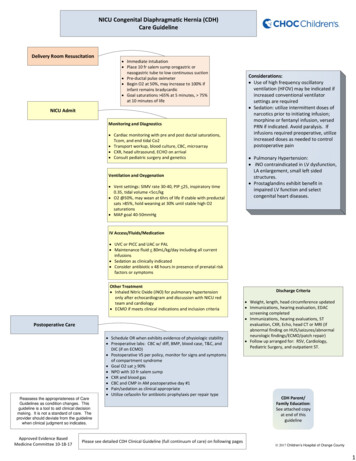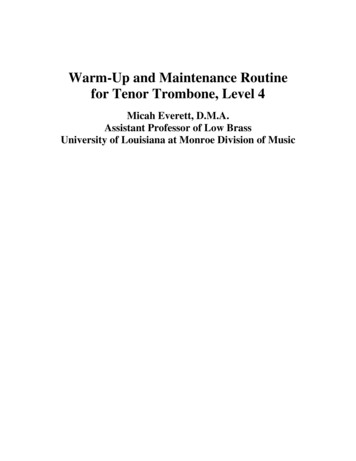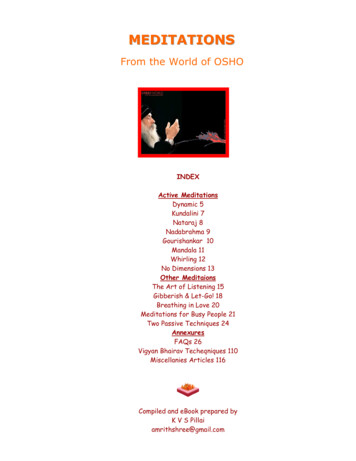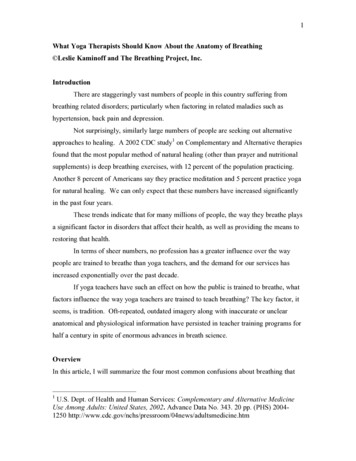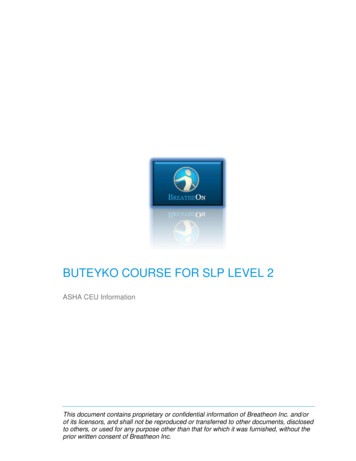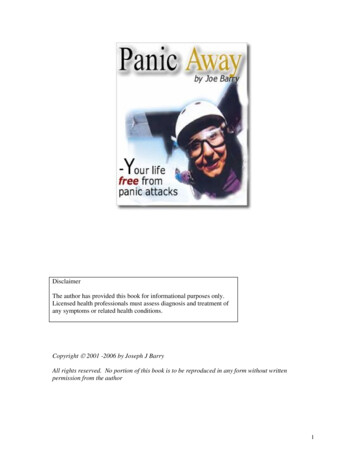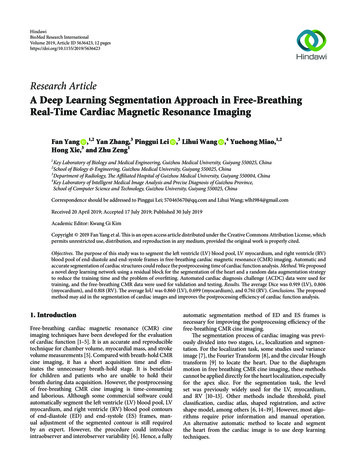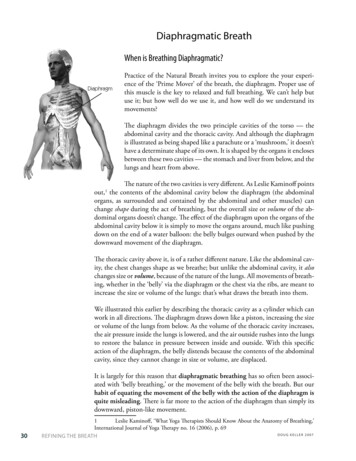
Transcription
Diaphragmatic BreathWhen is Breathing Diaphragmatic?DiaphragmPractice of the Natural Breath invites you to explore the your experience of the ‘Prime Mover’ of the breath, the diaphragm. Proper use ofthis muscle is the key to relaxed and full breathing. We can’t help butuse it; but how well do we use it, and how well do we understand itsmovements?The diaphragm divides the two principle cavities of the torso — theabdominal cavity and the thoracic cavity. And although the diaphragmis illustrated as being shaped like a parachute or a ‘mushroom,’ it doesn’thave a determinate shape of its own. It is shaped by the organs it enclosesbetween these two cavities — the stomach and liver from below, and thelungs and heart from above.The nature of the two cavities is very different. As Leslie Kaminoff pointsout, the contents of the abdominal cavity below the diaphragm (the abdominalorgans, as surrounded and contained by the abdominal and other muscles) canchange shape during the act of breathing, but the overall size or volume of the abdominal organs doesn’t change. The effect of the diaphragm upon the organs of theabdominal cavity below it is simply to move the organs around, much like pushingdown on the end of a water balloon: the belly bulges outward when pushed by thedownward movement of the diaphragm. The thoracic cavity above it, is of a rather different nature. Like the abdominal cavity, the chest changes shape as we breathe; but unlike the abdominal cavity, it alsochanges size or volume, because of the nature of the lungs. All movements of breathing, whether in the ‘belly’ via the diaphragm or the chest via the ribs, are meant toincrease the size or volume of the lungs: that’s what draws the breath into them.We illustrated this earlier by describing the thoracic cavity as a cylinder which canwork in all directions. The diaphragm draws down like a piston, increasing the sizeor volume of the lungs from below. As the volume of the thoracic cavity increases,the air pressure inside the lungs is lowered, and the air outside rushes into the lungsto restore the balance in pressure between inside and outside. With this specificaction of the diaphragm, the belly distends because the contents of the abdominalcavity, since they cannot change in size or volume, are displaced.It is largely for this reason that diaphragmatic breathing has so often been associated with ‘belly breathing,’ or the movement of the belly with the breath. But ourhabit of equating the movement of the belly with the action of the diaphragm isquite misleading. There is far more to the action of the diaphragm than simply itsdownward, piston-like movement.30 Leslie Kaminoff, ‘What Yoga Therapists Should Know About the Anatomy of Breathing,’International Journal of Yoga Therapy no. 16 (2006), p. 69DOUG KELLER 2007REFINING THE BREATH
The second kind of expansion of the ‘cylinder’ that wedescribed was the expansionand contraction of the chest.This is usually understood tobe done by the muscles of therib cage and chest, which liftthe ribs like bucket handles toexpand the chest. The ‘top’ ofthe cylinder is likewise drawnupward — like another pistonat the top of the cylinder — bythe muscles of the shouldersand neck (serratus anterior,pectoralis minor, sternocleidomastoid and scalenes, whichwe use when our breath is especially labored). We referredto this earlier as ‘clavicular’breathing.Accessory Muscles Used for InhalationAccessory Muscles Used for ExhalationSternocleidomastoid (SCM)ScalenesPectoralis MinorInternal IntercostalsPectoralis MajorSerratus AnteriorExternal IntercostalsExternal ObliquesDiaphragmon InhalationRectus AbdominisTransversus AbdominisInternal ObliquesThe muscles used in this sideways and upwards expansionAccessory Muscles Used for InhalationAccessory Muscles Used for Exhalationof the chest are generally unRedrawn from illustration in International Journal of Yoga Therapy no. 16 (2006) p. 74derstood to be secondary oraccessory muscles for the breath. They are meant to assist us in breathing, but theyare not designed for the 24-7 work of the breath. Their overuse is most often defined as ‘chest breathing,’ which is in turn considered to be a stressful pattern of‘overbreathing.’Chest breathing as a form of overbreathing is indeed not good. But is all movementof the chest the same as this kind of chest breathing? The distinction is often basedon where we most observe movement with the breath. If the abdomen expands onthe inhalation, it is regarded as a ‘diaphragmatic’ breath. If the chest expands — andthe abdomen moves little, or even draws inwards — during the inhalation, thensome yoga teachers regard this as ‘chest breathing’ and treat it as the very oppositeof diaphragmatic breathing — and more ‘belly breathing’ is encouraged.We’ve already noted that movement of the mid and upper chest is part of the ‘naturalbreath’ or a very complete breath, and that overbreathing usually consists of overuseof chest breathing and clavicular breathing. Now we’re taking a moment to focuson the question of whether a false dichotomy is being used when students are beingtold too easily and too often that they are ‘chest breathers.’ The diaphragm movesin more than one way, and the quality and efficiency of our use of the diaphragmdepends upon the interaction of the two cavities of the torso. When we look moreclosely, we realize that the diaphragm is really the prime mover of breath as it takesplace in the chest as well. The difference between ‘good’ and ‘bad’ chest breathingrests upon the balance struck between changes in the two cavities of the body duringDOUG KELLER 2007REFINING THE BREATH31
the process of breathing. Awareness of this balance, mediated by the diaphragm,takes us a long way in refining the movement of efficiency of the breath. The balance is the result of the rather unique nature of the diaphragm.The Diaphragm as a MuscleMost muscles connect from bone to bone, and are designed to move bones. Thebicep, for instance, has its origin at the upper armbone and its insertion at theforearm. When the bicep contracts, it pulls origin and insertion toward each other— most often drawing from insertion toward origin, such as when the elbow in a‘bicep curl.’The diaphragm does not join two bones, and what it ‘does’ is rather unique. The originof the diaphragm is where it attaches along a rim that begins at the bottom of thesternum, and extends around the base of the rib cage to the front of the lower spine.The only ‘bony’ attachments are at the back of the xyphoid process and the frontof the lumbar vertebrae. Therest of what the diaphragm attaches to is flexible tissue: thecartilage and ligaments of theeminently mobile ribs.Central Tendonof the diaphragm— its insertionTr a n s v e r s eabdominisOrigin of the diaphragm— at the bottom of thesternum (Xyphoid process), base of the ribcage (costal cartilage),front surfaces of the firstthree lumbar vertebraeQuadratuslumborumPsoasThe ‘insertion’ of the diaphragm is the top of theflattened ‘dome’ it forms— or more precisely, thedome formed by the way itrests upon organs such as thestomach and liver below it.The very top of the dome isnon-contractile tissue. Thisforms a ‘tendon’ that is notattached to any bone; ratherit inserts into itself! IliacusAnterior LigamentTailbonePelvic DiaphragmIliopsoas MinorThe Diaphragm: Its Origin and InsertionRedrawn from illustration in International Journal of Yoga Therapy no. 16 (2006) p. 7232 REFINING THE BREATHIbid., p. 72DOUG KELLER 2007
Two Manifestations of Breath from the DiaphragmRibs fixed,unmoving:relaxedRibs mobile,allowing chestto expandThe belly is heldhard or ‘fixed,’ notallowing the abdomen to changeshapeThe belly movesoutward on theinhalationDiaphragmatic Inhalation when the ribs are fixed:the central tendon is pulled downward, and thebelly and lower ribs expand. The abdominalcavity changes shape because of displacementby the diaphragm; the diaphragm thus initiatesthe breath in the ‘belly’ (and lowest ribs)Neutral DiaphragmDiaphragmatic Inhalation when the abdominals areheld firm: the central tendon cannot move, so thecontraction of the diaphragm pulls upward on thelower ribs, causing the rib cage to begin to expand.Here the diaphragm initiates the breath in the chest.Movements Initiated by the DiaphragmLike every other muscle, the diaphragm contracts. But what the diaphragm causesto move depends upon what is allowed to move — either the belly or the chest.or both:— If the rib cage does not move (i.e. the muscles of the rib cage arenot used to expand it), then the contraction of the diaphragm pullsthe central tendon downward, pushing down upon the contents ofthe abdominal cavity. The result is that the belly (and the lower ribs)expands or ‘bulges,’ moved by the diaphragm. That’s not all. Thelower ribs are pushed outward by the contraction of the diaphragmalso. This is an important point of distinction between ‘belly breathing’ and genuine diaphragmatic breathing. Diaphragmatic breath isalways is ‘three-dimensional,’ an expansion that encircles the lowerribs, moving them without needing to enlist the intercostal musclesof the ribs. In ‘belly breathing,’ only the belly distends forward, andthe drag it exerts can actually limit diaphragmatic breathing.— If the abdomen is held firm by the abdominal muscles, then thecentral tendon does not move. Because the abdomen is holding itsshape and cannot be squeezed into something smaller, the centraltendon has nowhere to go. Instead, as the diaphragm contracts, itpulls upward on the lower rib cage (since it can’t move downward)and the lower rib cage expands outward — usually to an even greaterdegree than when the belly is allowed to move. If, of course, theabdominals are gripped too hard, the lower ribs won’t move, andthe breath will be entirely in the mid and upper chest.DOUG KELLER 2007REFINING THE BREATH33
It seems reasonable to say from this that the fullest expression of the diaphragmaticbreath comes when both belly and chest move to some degree, and in coordinationwith each other. Diaphragmatic breathing is not simply synonymous with ‘bellybreathing’ or with mere movement of the belly. The relaxed expansion and contraction of the chest — particularly when one is sitting or standing upright — isequally diaphragmatic. A full yogic breath also makes use of the accessory musclesof the chest for a complete yet relaxed breath. This does not make it any less diaphragmatic, but rather a diaphragmatic breath ‘plus’ — which is as it is intendedto be. The fullness and pacing of this breath is determined by the body’s needs inthe moment: certainly a full breath while one is doing a slow and steady — yetphysically challenging — asana practice will be different from the kind of breathingone does in preparation for meditation. The body’s demands in those two cases arequite different! This insight into the nature of diaphragmatic breath also helps us to better understand the classic role of the ‘bandhas’ in making the breath more efficient anddiaphragmatic. Uddiyana bandha — which we might simply define here as a gentletoning of the lower abdominal muscles just above the pubic bone (and the toningof the pelvic floor or Mulabandha that this action brings) — brings just the kind ofmuscular toning that serves to gently maintain the shape of the abdominal cavity.This toning is just enough to make the action of the diaphragm in the lower ribsall the more expansive.Notice that this ‘toning’ of the muscles in Uddiyana bandha refers to the lowerabdominals. If the abdominals as a whole were held firm (rectus abdominis inparticular, which is hard to maintain in any case, though an artificial attempt wasmade in the age of corsets), then not only would the abdominal cavity be preventedfrom changing shape to allow for the expansion of the lungs, but the lower ribs aswell would be immobilized, inhibiting the action of the diaphragm in every way.Then the breath would indeed have to be handled by the accessory muscles of themid and upper chest, making for very tiring and inefficient ‘chest breathing’ of thekind that we are warned against.Uddiyana bandha and the toning of the pelvic diaphragm (Mulabandha) providesthe necessary balance between tone and freedom in the abdomen. This allows thediaphragm to cause movement in the belly and expansion of the rib cage. The diaphragm can then act with such fine and relaxed coordination that one can smoothlyadd the assistance of the accessory muscles of the chest for a very ‘full’ yogic breath.The use of the bandhas in this very full style of pranayama comes into play primarily when the body is upright. We will turn to the distinction between this anddiaphragmatic breathing in reclining practice after the next section.34 If in the process of yogic breathing we are taking in more oxygen and dispelling more carbondioxide than the body needs at that time and level of physical activity, then we are overbreathingor hyperventilating, and not breathing ‘yogically’ at all. A breath can be very full without causingthese problems if the balance is maintained via proper pacing of the rate of the breath, assisted bypracticing with the Ujjayi sound, and a relaxed and receptive attitude.DOUG KELLER 2007REFINING THE BREATH
Oxygen, the Breath and StressWhen it comes to delivering oxygen to the blood efficiently, diaphragmatic breathingdoes the job best, in large part because of the structure of the lungs themselves. Amajor portion of the blood sent to the lungs goes to the lower parts, largely becauseof the influence of gravity. The lower lobes of the lungs are the largest, and the lowerparts of the lungs expand the most as well, because of the action of the diaphragm.Thus the breath is brought first to the most blood-rich parts of the lungs.There are times when the body physically needs more oxygen because of physicaldemands placed upon it, and the use of the accessory muscles of the rib cage aredesigned to increase the volume of the chest more and more, bringing more breathinto the lungs to meet the need for more oxygen.And then there are times when we anticipate physical stress and begin to breatheharder, using the chest muscles. The problem is that this situation of persistentmental and emotional stress has become more the rule of daily life than the exception. The body is on constant alert via the sympathetic nervous system, but thephysical exertion — and the need for accelerated breathing — never comes. Asa result, we’ve both pumped in more oxygen and pumped out carbon dioxide inthis process of hyperventilation, and a vital chemical balance in the body has beenseriously upset.Here begins the vicious cycle that is so familiar to hyperventilators. The harder webreathe, the more oxygen-starved we feel, and we can’t ‘catch’ our breath. This is notfor lack of oxygen, but because so much carbon dioxide has been forced out in theprocess of overbreathing. The presence of carbon dioxide in our blood allows thehemoglobins to transport oxygen to the body’s tissues. If too much carbon dioxideis ‘blown off’ by hyperventilation, the blood becomes alkaline, and the hemoglobincan’t release the oxygen molecules, which are chemically ‘stuck’ to it. The blood iscarrying around plenty of oxygen: the problem is that the body can’t get any of it!Carbon dioxide also provides the chemical message in the blood that leads us to takeour next breath. At the end of the exhalation, there is a natural, restful pause beforewe breathe in again. During that pause, carbon dioxide builds up in the blood at thesame time that oxygen is being released into the tissues. When it reaches a certainlevel, the respiratory center of the brain sends a signal through the phrenic nerveto the diaphragm to take another breath. In the normal course of breathing, theentire process of respiration is driven by carbon dioxide, from the first neurochemical impulse that initiates the inhalation, to the chemical balancing act in the bloodthat delivers oxygen to the body. All of this happens without our having to thinkabout or consciously direct the process, and the whole process works astoundinglywell, with carbon dioxide playing a central role from beginning to end.That, of course, describes the natural process of the breath, in which the consciousmind, with its slurry of desire, emotion and expectation, is not factored in. But what Ibid., p. 76Ibid., p. 76DOUG KELLER 2007REFINING THE BREATH35
happens when we overbreathe? Usually an excess of carbon dioxide in the bloodtells us to take another breath in, and the process is quite relaxed. But when carbondioxide drops below a certain level, the message from the body — which is nownot receiving the oxygen it needs — is that we are suffocating! And so the breathis driven by the body’s panic, and we breathe harder, making the situation worseinstead of better. A subtle chemical imbalance soon becomes a full-blown panicattack. The age-old cure for panic attacks — to breathe into a paper bag — has avery good biochemical basis: it’s meant to increase the levels of carbon dioxide byre-breathing the same air, until the proper balance is restored. When it comes to stressful breathing patterns, or patterns of ‘overbreathing, certainlythe vicious cycle of the biochemistry of hyperventilation plays the part of gasolinethrown on the fire. Mental anticipation and anxiety, however, is the match that lightsthe fire. The biggest challenge in establishing healthy breathing patterns — especiallyin the conscious practice of pranayama — is the mind, with its desires, conditioning, and love of exerting control in all things. The mind, far more than the body,introduces the greatest interference to the natural breath. Witness any beginner’spranayama class: even in a relaxation in which students are told to simply watch thebreath, many become uncomfortable and confused about the breath, feeling thatthey no longer know how to breathe, even though they were doing a reasonablygood job of it when they arrived for class! Such can be the influence of the mind,when attention is turned toward the breath.The Purpose of Pranayama RevisitedGiven that the natural process of the breath works best when there is the least interference, what is the purpose of pranayama as a conscious practice, especially when‘consciousness’ of the breath introduces the interference of the mind?Is it, as is sometimes taught, to better oxygenate the blood? As we’ve just seen,oxygenation usually not the problem, and the harder we try to do so, the worsewe make our situation. More oxygen can become a problem, especially when weoverbreathe.Leslie Kaminoff, who emphasizes the need to understand the anatomy and physiology of breathing in order to dispel misconceptions about pranayama, defines thepurpose of pranayama in this way:“.in yoga we train ourselves to breathe deeply, and in a varietyof unusual patterns, but this is only for the purpose of exploringthe full potential of our breathing mechanisms, and to uncoverand dismantle habits that obstruct normal function. In otherwords, the end goal of practicing pranayama (unusual breathingpatterns) in a Yoga therapy breathing intervention is to achieve“normal” breathing. Normal breathing, in the physiologicalsense, means that our everyday, moment-to-moment respiratory activity is consistent with our metabolic requirements.” 36 REFINING THE BREATHIbid., p. 76Ibid., p. 75DOUG KELLER 2007
Indeed, tantric philosophers of yoga as well as the later Vedantins, such as theauthor(s) of the Yoga Vasistha, agree that the highest pranayama is the natural,uninhibited breath. The purity of the breath is embodied by the ‘So’Ham’ mantra,the natural mantra of the breath.Yet they might take issue with Mr. Kaminoff’s definition of pranayama as ‘unusualbreathing patterns’ and urge instead that the practice be defined by its purpose. Andthey link the purpose of yogic breathing back to the purposes of yoga. Thus theymight define pranayama as a conscious form or practice of breathing that leads tothe natural stilling of the prana, and thus to the natural stilling of the mind.Mr. Kaminoff’s definition focuses — as do many contemporary accounts of pranayama — more narrowly on the therapeutic value of pranayama practice, especially asan ‘intervention’ in the case of unhealthy patterns of breathing. His emphasis on thebiochemistry and physiology of breathing is very necessary and helpful in correcting misunderstandings in the teaching of pranayama, so that pranayama practicedoes not inadvertently increase stress rather than overcome it. Seen in the light ofmetabolic processes, he points out that“from this perspective, the notion of taking deep, slow breathsat all times is revealed to be a recipe for metabolic mayhem.Similarly, the oft-repeated dictum that Yogic breathing is supposed to maximize oxygen intake and carbon dioxide elimination is just as flawed. If we were truly able to accomplishthis feat, then all Yogic breathing would, by definition, behyperventilation — that is, the physiological state in whichthe blood contains too much oxygen and not enough carbondioxide.Hyperventilation refers to the chemical conditionof the blood, not to a particular pattern of rapid or shallowbreathing.” This last point regarding the meaning of hyperventilation is a very helpful one, andis in large part the reason for our use of the term ‘overbreathing’ when talking aboutbreathing patterns, as distinct from ‘hyperventilation.’ Nor would anyone be rightin recommending that we take ‘deep, slow breaths at all times.’ But what aboutduring relaxation and meditation? Is this too a ‘recipe for metabolic mayhem?’ Andwhat should we understand to be the purpose of this breathing?In an eminently contemporary turn of phraseology, he suggests that “more accurateteaching language would refer to normalizing levels of oxygen and carbon dioxidein the body. However, as many students do not find discussions of biochemistryparticularly inspiring or relaxing, I suggest that Yoga teachers use the terms pranaand apana when referring to these concepts.” Here Mr. Kaminoff effectively reducing these age-old Sanskrit terms, and least in thetherapeutic context of yoga, to a more biochemical definition. Prana and apana are Ibid., p. 76Ibid., p. 76DOUG KELLER 2007REFINING THE BREATH37
The heart is of the nature ofpure consciousness. It is bothinside and outside, and it isneither inside nor outside.That is the principal heart. Init is reflected everything whichis in the universe and it is thetreasurehouse of all wealth.Consciousness alone is theheart of all beings, not the pieceof flesh which people call theheart!Hence, if the mind, freed of allconditioning, is gathered intopure consciousness [the heart],the movement of prana isrestrained.The Concise Yoga Vasistha(p. 239)simply more palatable terms designed to help us teach a more enlightened understanding of the purposes of pranayama — which focuses more on blood chemistrythan on mental states and conditioning.But here is where the age-old practitioners of pranayama would take issue. We riskforgetting that pranayama — even in a more narrowly defined therapeutic context— has to do with the relationship of the breath to the mind, not just the metabolicprocesses of breathing. Certainly the biochemistry of our blood can affect ourbreathing processes and thus our state of mind; but haven’t we seen how muchmore profoundly our state of mind can affect the breath, and thus the body? Andit is the mind, not just the biochemistry of hyperventilation, that perpetuates thevicious cycle of overbreathing. Pranayama as a conscious practice of breathing is anopportunity to become aware of mental conditioning and the breathing patternswith which they are associated, and gives us the tools for dissolving that conditioning. In this context, the terms ‘prana’ and ‘apana’ take on much more expanded andsignificant meaning. Both ‘mind’ and ‘prana’ need to be more deeply understood,and experientially so. This is where practice enters in.In the Yoga Vasistha we find this account of pranayama:“Prana is indistinguishably united with the mind. In fact,the consciousness that tends toward thinking, on account ofthe movement of prana, is known as the mind. Movement ofthought in the mind arises from the movement of prana; andmovement of prana arises because of the movement of thoughtin consciousness. They thus form a cycle of mutual dependence,like waves and movement of currents in water.The wise ones declare that the mind is caused by the movementof prana; and hence by the restraint of the prana, the mindbecomes quiescent.The movement of prana is arrested by the effortless practiceof breathing, without strain.The practice of exhalation, whenthe prana roams in space without touching the limbs of thebody, of inhalation, leading to the peaceful movement of prana,and of retention, bringing it all to a standstill for a long time,all lead to the arrest of the movement of prana.These yogamethods bring about the desired results if they are practicedwithout violence or force.”10The key point in this account is the phrase, “without force.” The practices of thebreath we will cover, beginning with diaphragmatic and Ujjayi breath, are meantto return us in various ways to the naturalness of the breath by practicing themconsciously, yet without force or interference from the ego. The very effort of thiseffortless-effort is to dissolve the conditioning of the mind that leads to dysfunctional patterns.3810REFINING THE BREATHThe Concise Yoga Vasistha, Swami Venkateshananda, p. 239DOUG KELLER 2007
When it comes to the depth and pacing of the breath, along with the patterns ofpranayama introduced as practices, we surely do explore the full potential of ourbreathing mechanisms, and dismantle counterproductive habits — especially thephysical ones. That is the first step of practice.But in moving beyond that, we begin to explore our experience of the movementof the prana, which is the subtler energy that moves both the physical breath andthe mind. Are the terms ‘prana’ and ‘apana’ simply arcane terms for the biochemical triggers (having to do with carbon dioxide levels in the blood) which signal thediaphragm — via the respiratory center in the brain — to take another breath in orout? Or is there more to ‘prana’ than fits into the physiology of breathing?This is something to be explored in our experience of the movements of inbreathand outbreath, and of the spaces of stillness in between: “the practice of exhalation,when the prana roams in space without touching the limbs of the body; of inhalation, leading to the peaceful movement of prana, and of retention, bringing it all toa standstill for a long time, all leads to the arrest of the movement of prana.”11We align ourselves with the subtlety of this energy when the process is unforced.In practice, the mind and physical breath become more and more entrained to thisenergy, the more every moment of the breathing process becomes an experienceof stillness (even in movement). We even experience spontaneous cessations of themovement of the breath (kumbhak or natural retention of the breath) for long periods of time. In this cessation, we experience the natural stilling of the mind andthe urges that drive it.This cessation too has to be unforced, and the experience of it can be subtle andfleeting, since the mind is quick to try to jump in, grasp and control or extend it.But in those moments, which increase as we learn to be receptive and open in ourpranayama rather than goal-oriented and grasping, we experience the pure essenceand significance of pranayama, which is to experience our merging with a consciousenergy deeper than the processes of both mind and body. In that experience, weloosen the bonds of the mental attitudes and conditionings by which we ordinarilyset ourselves apart from that experience, and apart from our own higher Self. Theessence of that experience is the fully conscious surrender to that higher Self.The first step toward that experience is to return to the diaphragmatic breath,awakening ourselves to the fullness and naturalness of this experience. And so it isto this that we now turn.Excerpt from the newly revised fourth edition of Refining the Breath by DougKeller11Ibid., p. 239DOUG KELLER 2007REFINING THE BREATH39
As Leslie Kaminoff points out, the contents of the abdominal cavity below the diaphragm (the abdominal organs, as surrounded and contained by the abdominal and other muscles) can . Leslie Kaminoff, ‘What Yoga Therapists Should Know About the Anatomy of Breathing,’ International Journal of
